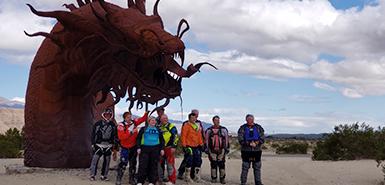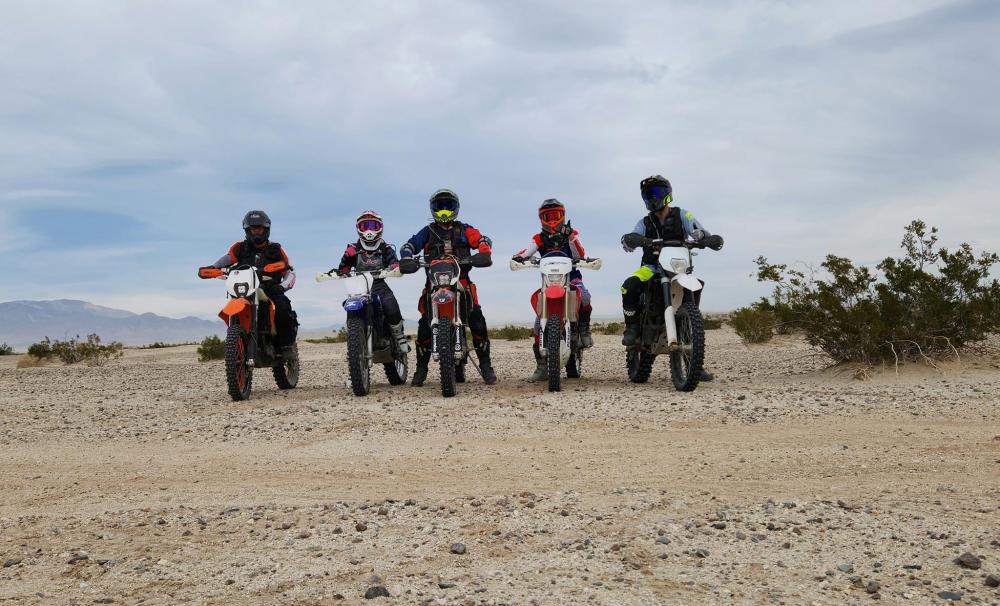-
Content Count
3050 -
Joined
-
Last visited
-
Days Won
4
Posts posted by Oracle
-
-
11 minutes ago, tntmo said:Yeah, if that’s the little coffee shop?
Yes, that is the usual spot. It just changed names. Have fun guys.
-
 1
1
-
 1
1
-
-
As a Sheriff's Department SAR team member, I'm familiar with this situation. Law enforcement is on top of this investigation. That's all I'm going to say on a public forum.
-
 1
1
-
 1
1
-
 1
1
-
-
A tent. WTH. You getting soft in your old age...🤣
-
I prefer the Gortex gear over carrying an extra rain suit. I hate bulk and extra layers and the gortex (in my case, the older version of the Klim Carlsbad) has always worked pretty well for me riding through storms in Arizona, Utah, Colorado, California deserts, etc. And the newer Carlsbad jacket has more and better venting than the one I currently have making it an even better option. Goofy, send me a PM for info on a possible Klim discount.
-
 1
1
-
-
Call Sole Performance in Encinitas. They may be able to help.
-
 1
1
-
-
We should have been more neighborly and invited you into the converstation. Next time for sure. I'm in Ramona too so I'm sure I'll see you around more. How was Lusardi?
-
That's me in the white t-shirt with my back to the camera. I passed you on the way down the hill. Hope I didn't roost you...😁
-
 1
1
-
 1
1
-
-
I'm curious where you ran across the bear? I had a bear run out in front of me on 1N16, just west of the crossing with 1N09 a couple of years ago.
-
55 minutes ago, Goofy Footer said:Can you explain for members the process of how to request a SAR Activation and the potential reflex time of resources? Even as simple as who to call.
It is important information for people’s timelines when making the critical decision to ask for help.
Sure. First, let's be clear about one thing. Activating your Spot or Inreach, is not the same thing as activating SAR. To keep it simple, Inreach and Spot will activate a response to your emergency in the form of law enforcement and medical services, via GEOS (then forward to 911). Since Spot and Inreach know exactly where you are at, it has nothing to do with Search and Rescue (SAR). With that said, I suppose a Spot activation could turn into a SAR mission at some point if the first responders were unable to locate the person who activated their device.
Now, as far as San Diego is concerned, and most other areas I'm aware of, a SAR mission will be initiated after several key members have assessed the situation and determined a SAR call-out is warranted. It will almost always start with a call to law enforcement. Usually in response to a missing person obviously (but there are other missions we handle). The reporting party will provide details to the responding officers/deputies. The deputies will advise a supervisor. The supervisor will determine if a call to the SAR coordinator is warranted. The SAR coordinator will then assess the information and make a final determination if there will be a SAR call-out, and if so, which resources. We have several different assignment groups. Not all will be sent all the time.
Once SAR has been activated, team members will start showing up within about an hour anywhere in SD. The team members on the scene will start collecting pertinent information and establishing a place to set up a command post. Resources like the actual command post might take up to two hours to arrive. A supervisor will put together a search plan and start sending out teams.
So, to summarize, let's say you are out in the desert and riding with a group of friends. One person goes missing. You get to the point where you need to call for help. Start by calling 911. The deputies or officers that arrive on the scene will assess the situation and make a decision on whether or not to start the SAR process.
Anyone have any questions about San Diego Sheriff's Department SAR, let me know.
BTW, we do have a dual sport response team, which I am a member of. I also am field certified for searches and a member of the motorized unit, which provides transportation to search teams in remote areas via 4x4 vehicles.
-
 2
2
-
-
As your local SDSO SAR member, I approve of this message.
-
 1
1
-
-
On 3/8/2023 at 1:09 PM, MacDuncan said:Heads up to any going to Alamo Lake area.... I looked at that route to Alamo Lake on the internet before heading out a few days ago and a bunch of folks shared that some of the entry points were so flooded that many pieces of the route that connect to that area were swamp like... but I didn't confirm in person... but KOFA was spectacular!
Good info. I should have thought of that before with all the rain and snow. So what route did you ride? 525 running good?
-
Also applied to LE and FD.
I'm a big fan of Klim. I have two full sets of adventure gear and one set of MX gear. I recently went down on the street (don't tell anyone) in my Klim Adventure gear, slid across two lanes of traffic and into a berm. Broke my thumb and banged up a couple of ribs and my hip. My Klim gear held up extremely well with just some minor scuffs on the pants and minor scuffs on the sleeve of my jacket, with a minimal amount of burn-through in the elbow area—no road rash for me. I think I'll order some more right now. To hell with the new water heater...
-
 2
2
-
 2
2
-
-
On 2/25/2023 at 1:57 PM, SANRider said:Not so black today. All the gates closed up there I assume?
Yes, they are closed.
-
The section of the Peace trail south of Quartzite (south of the 10) is my least favorite. The section north of Quartzite is beautiful. And there are many offshoots. You could take one of those offshoots eastward over to Almo Lake, then use the main trail to head south. There are some great camping opportunities. You could then loop clockwise to Yuma and start the section between there and Quartzite as you head back north. There are many bailout points so when you get sick of all the rocks, you can jump on two lane and slab back to Quartzite.
-
 1
1
-
-
On 2/25/2023 at 8:55 AM, Bagstr said:Say Buddy, Will you change my tire for me? 🛞
You know I would...
-
Nope. I do it the old fashion way....with a good set of spoons. I have no desire to carry that much bulk and weight with me when I'm out adventuring. The big rear tires on ADV bikes are easier than most people think....once you break the bead (the hardest part of the change). Just because the tire is bigger, doesn't means it's more difficult.
-
I have one in my tool box....and that's where it stays. I can see how it might be helpful for some, but I've changed 100's of tubes at this point and it just slows me down.
-
-
Not only is it jeepable, it might even be fun in a Jeep. Although it will obviously take much longer.
-
 1
1
-
 1
1
-
-
18 hours ago, Goofy Footer said:@Oracle and @Riggerdan here is a post from that couple you met. I'm not on HUBB to see how far they made it but hopefully they did!
Thanks for sharing that.
-
We past each other on the 78 as I was going east and you were going west, right near the entrance for the Santa Ysabel Preserve hiking trail....small world.
-
 1
1
-
-
I've done it on an adventure bike and on my 500. I ride faster than most and probably longer hours per day. I start in Ramona and am in Yuma by noon (and that's with about 50/50 dirt / street ) for lunch. Gas up, grab some beer, and finish the ride out to Pichaco Campground for the first night. From Pichaco it's on trail to Blythe for gas and lunch. Continue on all the way to the Mojave National Preserve, where there are some great camp spots. Up in the morning, hit Primm for gas, and continue on to DV for a stop in Furnace creek, so on and so forth. I only camp. And I've had some amazing nights camping and some very horrible nights camping. One of the worst was on CABDR in March 2019 with Rigger Dan when we got caught in this....https://en.wikipedia.org/wiki/March_2019_North_American_blizzard#:~:text=Rapid snowmelt following the storm,over a 24-hour period. Even though we were on the far west outskirts of this system, it was pretty gnarly.
-
 1
1
-
-
14 hours ago, Goofy Footer said:@Oracle + @Covered in Dust how did the NVBDR turn out? How was the route? Was Late Sept / Early Oct a good weather window for the route? Did you ride it door to door from SD?
Any intel is Great for my personal planning purposes.
It was a bust. About five days before we left, the weather took a significant turn for the worst. Much of the NVBDR is at altitude and it looked like the lows would be in the low 20's, maybe even into the teens, at night for more than half of the ride. So at the last minute, I put together a five to six day ride in Arizona, half of which included the AZ BDR tracks and half was new tracks. The weather looked to be ideal for Arizona. We were all set to pull out on a Tuesday morning, and everything was lined up. I finished prepping my bike on Sunday, including installing new tires. I got my bike all loaded up and decided to take it for a quick shake down around the block (which for me includes Highland Valley Road) to make sure everything was secure. My bike washed out in the first corner on HVR and I went down hard. Got scraped up a bit and broke my thumb. So bottom line, I was out. The rest of the group continued on to the Arizona ride, but ended up turning around after a couple days and heading south as a result of the weather getting too cold there too.
-
Thanks. Looks amazing. I'd love to make it but have a two dayers lined up for this weekend. I'll keep track for next year.
LB



.thumb.jpg.1a260d1aa0fceee87701c4702dc0cc14.jpg)

Gore-Tex is a Marketing Gimmick
in Personal & Riding Gear
Posted
I'm one of the only riders on this planet who can't stand that guy....so I won't watch his video.
But I've been wearing gortex jackets and pants for years on motorcycle rides and have had great experiences with them.
LB out!